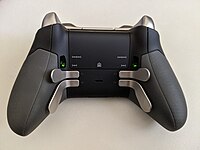Xbox Wireless Controller
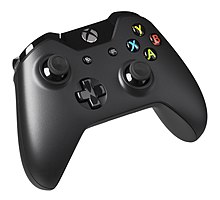 A black Xbox 2013 Wireless Controller | |
| Developer | Microsoft |
|---|---|
| Manufacturer | Microsoft |
| Type | Video game controller |
| Generation | Eighth and ninth generation |
| Release date | |
| Lifespan | 2013—present |
| Input |
|
| Connectivity |
|
| Current firmware | 2.3.2385.0 5.13.3143.0 (second revision) 5.13.3143.0 (third revision) |
| Dimensions | 6.02 in × 4.01 in × 2.4 in 153 mm × 102 mm × 61 mm |
| Predecessor | Xbox 360 controller |
The Xbox Wireless Controller is the primary game controller for the Xbox One and Xbox Series X/S home video game consoles, also commercialized for its use in Windows-based PCs, and compatible with other operating systems such as macOS, Linux, iOS and Android. The controller maintains the overall layout found in the Xbox 360 controller, but with various tweaks to its design, such as a revised shape, redesigned analog sticks, shoulder buttons, and triggers, along with new rumble motors within the triggers to allow for directional haptic feedback.
It has had three revisions with several changes to the controller's design and functionality. Microsoft also markets the Elite Wireless Controller, a premium version geared towards professional gamers, including interchangeable parts and programmability features. In turn, each of the aforementioned variations has been offered in various color schemes, some featuring special designs tying into specific games. The Xbox Series X and Series S introduced an updated version of the controller, with further refinements to its shape and ergonomics.
Layout
The Xbox One controller retains roughly the same layout as the Xbox 360 controller, including four main face buttons, two shoulder bumpers, two analog triggers, two analog sticks and a digital D-pad. The "Start" and "Back" buttons are replaced by "Menu" and "View" buttons, while the Guide button now consists of a white backlit Xbox logo, and does not feature the "ring of light" that served as an indicator for the controller's assigned number (1 to 4).
Design
Microsoft invested over $100 million into refining the controller design for the Xbox One; internal designers had created prototypes with various tweaks and refinements to the design over the Xbox 360 controller, along with those including unorthodox features such as embedded screens and speakers (which were rejected due to their effects on battery life, and redundancy to the main display and sound system), and the ability to emit odors.[1]
The Xbox One controller maintains the overall layout found in the Xbox 360 controller's design, but with enhancements such as redesigned grips, a smoother build, and the removal of the protruding battery compartment. The controller also contains light emitters that allow it to be tracked and paired using Kinect sensor, and to detect when it is not being held to automatically enter a low-power state. The controller contains a micro USB port, enabling wired use of the controller with the console or on computers running Windows 7 or later with drivers, and firmware updates.[2][3][4][5] For communication, the controller uses a new proprietary protocol with a greater bandwidth than the wireless protocol used by the Xbox 360 controller, reducing latency and allowing for higher quality headset audio.[3][4] Up to eight controllers can be connected wirelessly to the console at the same time; if controllers also are supporting wireless chat audio via the Chat Headset, four controllers can be connected simultaneously, and if the controllers are providing wireless chat and stereo in-game audio via the Stereo Headset, two controllers can be connected simultaneously.[6]
The analog sticks feature a new textured rim, while the D-pad was changed to use a more traditional 4-way design rather than the circular 8-way design of the 360 controller. This change was made partially due to criticism by players of fighting games who, despite the use of "sweeps" across the D-pad in these games being part of the motivation for the 8-way design, felt that the Xbox 360's D-pad performed poorly in that type of game. The updated 4-way design is also better suited for use as individual keys in games that use them for item selection.[7] The design of the face buttons was revised to improve their legibility, using a three-layer design consisting of a black background, colored letter, and a clear covering intended to make the letter appear to "hover" inside it. The buttons themselves are also spaced slightly closer together.[8]
The bumpers and trigger buttons were overhauled with a new curved shape to improve their ergonomics, as the user's fingers now naturally lie at an angle upon them unlike the straighter design on Xbox 360 controllers. The bumpers were also made flush with the triggers. The triggers themselves now have a smoother feel, and were made more accurate.[8] Each trigger features independent rumble motors called "Impulse Triggers", which allows developers to program directional vibration. One trigger can be made to vibrate when firing a gun, or both can work together to create feedback that indicates the direction of an incoming hit.[9]
Xbox Wireless
After 2016, when Bluetooth connectivity was introduced with the second controller revision (Model 1708) alongside the Xbox One S, Microsoft rebranded its proprietary connection protocol as "Xbox Wireless".[10] Xbox Wireless uses a higher frequency than Bluetooth (2.4 GHz), improving bandwidth and lag. Starting in 2017, Microsoft began working with third-party manufacturers to produce additional accessories using Xbox Wireless, with the first class being headsets.[11]
With a firmware update that began rolling out in September 2021, controllers with Bluetooth are able to pair with devices using both wireless protocols, allowing those controllers to switch connections by double-tapping the pairing button.[12]
Models
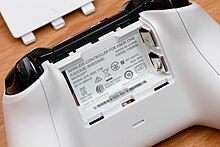
Original version (2013)
The original controller launched with the Xbox One console in November 2013 was black, with colored face buttons. A commemorative white variant was issued to Microsoft employees at launch, but was not available to the public until almost a year later, initially bundled with a matching white console and Sunset Overdrive.
First revision (2015)
On June 9, 2015, Microsoft unveiled a revised version of the standard controller, with model 1697. Its shoulder buttons were redesigned for improved responsiveness, a 3.5 mm headphone jack was added near the controller's expansion port, and support for wireless firmware updates was added.[13][14]

Externally, few changes were made; the main distinguishing feature of the 2015 revision (Model 1697) compared with the original (Model 1537) is the presence of the headphone jack on the bottom of the controller.
Second revision (2016)
A second revision of the controller, model 1708, was introduced alongside the Xbox One S, an updated model of the Xbox One console unveiled in June 2016. It features textured grips, and additionally supports Bluetooth for use with compatible PCs and mobile devices.[15][16] Users can also custom-order this controller revision via the "Xbox Design Lab" service, with their choice of colors, and an optional inscription of their Xbox Live screen name for an additional fee.[17]
The second revision can be distinguished from prior revisions by the color and texture of the plastic surrounding the lit Xbox/guide button. Prior controller models (1537 and 1697) have a separate piece of black glossy plastic, with the Model 1698 "Elite" also having a separate piece in black, dark red, or white. In the second revision (Model 1708) the front shell of the controller is a single piece, and the part surrounding the Xbox button now matches the texture and color of the controller. It has been made available in white, black, red, and blue colors, as well as other limited edition colors.[18]
Third revision (2020)

A third revision of the controller was released in November 2020, bundled with Xbox Series X and Series S, while still backwards compatible with existing Xbox One consoles. It has a refined build with a slightly smaller body, a "Share" button on the center of the controller below the "View" and "Menu" buttons, a circular dished D-pad similar to the Elite Controller, and a USB-C connector instead of USB Micro-B.[19][20][21] The controller also supports Bluetooth Low Energy, and can be paired to a Bluetooth device and an Xbox device simultaneously.[22][23] The controller also includes Dynamic Latency Input, sending controller information to the console more frequently and in time with the current framerate as to reduce the latency between user input and reaction in the game.[24] Starting in September 2021 through the Xbox Insider program, Microsoft started rolling out the improved Bluetooth and latency features from these newer controllers to its official Xbox One controllers, including the Xbox Adaptive Controller.[25]
Microsoft announced in June 2021 that the Xbox Design Lab will continue with the Series X/S controllers, allowing users to create their own custom designs.[26]
Summary
All of the controllers in this table are fully compatible with any of the Xbox One consoles, up to Series X/S.
| Model[a] | Intro. | Disc. | 3.5 mm jack | Bluetooth | USB | Thumbnail | Notes |
|---|---|---|---|---|---|---|---|
| 1537 | 2013 | 2015 | Micro-B | 
|
Controllers packed with launch-day systems are marked "DAY ONE 2013" with chrome d-pad. Microsoft employees were given a customized white version of the 1537 controller marked "I made this".[27] | ||
| 1697 | 2015 | 2016 | 
|
Standard 3.5 mm audio jack added to bottom of controller.[28] Capable of receiving firmware updates wirelessly from Xbox One console.[29] | |||
| 1698 "Elite" | 2019 | 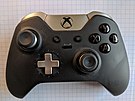
|
Interchangeable thumbsticks and d-pad; detachable paddles on underside duplicating face buttons; rubberized grip; trigger locks.[31] Standard color scheme is black and silver, but the Elite controller was later available in a predominantly red special edition Gears of War 4-branded theme and a Robot White theme. | ||||
| 1708 | 2016 | — | 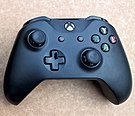
|
Introduced with the Xbox One S.[15] Distinguished from earlier versions by texture and color of plastic surrounding Xbox home button, which now matches the rest of the controller body. Includes Bluetooth connectivity in addition to the prior proprietary wireless protocol. | |||
| 1797[b] "Elite 2" | 2019 | — | USB-C | 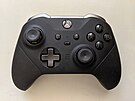
|
Compared to the 1698 "Elite", "Elite 2" adds a third trigger lock position, adjustable thumbstick tension, extended rubber grip (wrapping around to the front side), Bluetooth connectivity, and an internal rechargeable battery.[32] | ||
| 1914 | 2020 | — | 
|
Introduced with the Xbox Series X and Series S consoles, featuring a slightly smaller body, a "Share" button, a flat concave D-pad similar to the Elite Controller, and a USB-C connector.[19][20][21] |
- Notes
Colors and styles
Besides standard colors, "special" and "limited edition" Xbox Wireless Controllers have also been sold by Microsoft with special color and design schemes, sometimes tying into specific games.[33]
Xbox Design Lab
| June 2016[34] | |||||
|---|---|---|---|---|---|
| *Retro Pink | *Lightning Yellow {Gold} |
*Glacier Blue | Electric Green | Oxide Red | *Regal Purple |
| *Deep Pink | *Zest Orange | Photon Blue | Military Green | *Midnight Blue | Abyss Black |
| *Storm Grey {Gunmetal Silver} |
*Ash Grey {Pewter Silver} |
*Robot White {Sterling Silver} | |||
| Summer 2017[35] | |||||
| *Desert Tan {Warm Gold} |
Sierra Brown {Bronze} |
*Mineral Blue | Ink Blue | ||
| June 2021[36] | |||||
| *Electric Volt <NEW> | *Carbon Black (Abyss) | *Pulse Red (Oxide) | *Shock Blue (Photon) | [ |
[ |
| Nov 2021[37] | |||||
| *Dragonfly Blue <NEW> | *Nocturnal Green (Military) | *Velocity Green (Electric) | |||
| Legend | |||||
| * | Currently available color (as of 2021) | ||||
| <NEW> | New color, no prior equivalent | ||||
| [ |
Color discontinued | ||||
| (Parentheses) | Color that was replaced by this new color | ||||
| {Curly brackets} | Metallic equivalent color added in 2017, if name inconsistent | ||||
Starting in June 2016, the Xbox Design Lab (XDL) service made custom color combinations available for the Xbox One S controller (Model 1708) at extra cost. Clients could choose one of fifteen colors for each of five different sections of the controller (body, back, bumpers, triggers, D-pad); one of eight colors for the thumbsticks; five choices for face (ABXY) buttons; and four choices for the View/Menu buttons.[34] According to Microsoft, this makes approximately eight million distinct possible combinations.[17][38] Access to the XDL service began on June 13, 2016, and customized controllers started to ship at the end of August;[39] the initial pricing was $79.95/$99.95 (US/Canada), with an additional $9.99/14.99 (USD/CAD) fee for laser-engraved text up to 16 characters.[17][38]
One year later in summer 2017, four additional colors were added for nineteen total choices[35] and the XDL customization service was extended to clients in Europe.[40] The 2017 update also expanded the thumbstick color selection to any of the nineteen choices,[35] In addition, each of the nineteen available colors had a corresponding metallic variant for the D-pad and triggers.[41] which were extra-cost options for the D-pad (US$2.99) and triggers (US$3.99); in most cases, the metallic color name was the same as the regular color, except for the greys (Robot White → Sterling, Ash Grey → Pewter, Storm Grey → Gunmetal) and yellow/browns (Lightning Yellow → Gold, Desert Tan → Warm Gold, Sierra Brown → Bronze).[35] Another extra-cost option was to add black rubberized grips (US$5.99) to the rear of the controller.[42] Base price in the UK was £69.99, with initial availability limited to the UK, France, and Germany starting in June 2017;[43] the XDL program was expanded to 24 more European countries starting August 21 of that year.[44] In November 2017, Microsoft made each of the 32 NFL team logos available as an option for the front of the controller, printed on a Robot White background; XDL controllers branded with an NFL team's logo started at US$94.99.[45]
Also in 2017, Xbox partnered with McCann London to launch the "Xbox Design Lab Originals" program; the program, which McCann called "The Fanchise Model", allows consumers to earn a portion of the sales by creating and marketing their custom designs through Xbox Design Lab. Social media influencers began advertising the service on April 1, 2017, and a feature that allowed consumers to "claim [their] design" was added to the store on May 1, with retail support commencing on May 30.[46] It was credited with increasing controller sales by 350%; the campaign was awarded the Grand Prix at the Cannes Lions International Festival of Creativity in 2018 by the Creative eCommerce Lions[47][48] and Clio Awards in multiple categories, including public relations and games.[49][50]
Camo and Shadow options were added for the front body in August 2018. The starting price with solid colors was lowered to US$69.99, and the Camo/Shadow front options started at US$79.99.[51] The 'Camo' option adopted the angular camouflage pattern from the "Forces" series of controllers and these were available in one of five base colors (Robot White, Military Green, Midnight Blue, Abyss Black, and Desert Tan). The 'Shadow' option adopted the gradient pattern from the "Shadow" series of controllers and were available in one of five base colors (Oxide Red, Bronze, Photon Blue, Deep Pink, and Mineral Blue; a sixth metallic "Sterling Silver" option was offered until September 30, 2018), fading to matte black.[52][53]
The XDL service was suspended temporarily from October 14, 2020[54] to June 17, 2021, when it restarted using the newest controller (Model 1914) introduced with the Series X/S; the price of a custom controller was reduced to US$69.95.[55] Of the nineteen colors previously available since 2017, three were updated (Abyss Black → Carbon; Oxide Red → Pulse; Photon Blue → Shock), one was new (Electric Volt), and two were dropped (Sierra Brown and Ink Blue), making eighteen colors available for the reboot. In addition, the options for the Camo/Shadow front, metallic accent colors, and rubberized grips were dropped.[36] Fourteen of the eighteen colors available in 2021 were produced using plastic with 30% post-consumer recycled material, by weight; the exceptions are Robot White, Pulse Red, Zest Orange, and Regal Purple.[56] In November 2021, one new color was added (Dragonfly Blue) and two of the green colors were updated (Military → Nocturnal; Electric → Velocity), making nineteen color choices again; in addition, the nineteen metallic-finish colors from 2017 were restored as extra-cost options for the D-pad and triggers, and black rubberized grip panels also returned as an extra-cost option.[37]
Elite controller
On June 15, 2015, during its E3 2015 press conference, Microsoft unveiled the Xbox One Elite Wireless Controller, a new controller which Xbox division head Phil Spencer described as being "an elite controller for the elite gamer". It features a steel construction with a soft-touch plastic exterior, along with interchangeable rear paddle buttons (with either short or long forms), analog stick tops (original Xbox One stick, a convex dome, and an extended version for increased accuracy), and directional pad designs (either the traditional four-way design, or a concave disc-like design), and "hair trigger locks" for the triggers that allow users to reduce the amount of distance required to register a press. Through software, users can customize button and paddle mappings and adjust the sensitivity of the triggers and analog sticks. Two button profiles can be assigned to a switch on the controller for quick access. The Elite Controller was released on October 27, 2015.[57][58][59]
Cosmetic variants
A special Gears of War 4-themed limited edition variant of the Elite controller was unveiled during Microsoft's E3 2016 press conference. It features a rustic, dark red color scheme with a blood splatter effect and the series emblem on the rear of the controller, and a D-pad disc with weapon symbols corresponding to the in-game weapons bound to these controls.[60]
A White Special Edition of the controller was announced on August 29, 2018. Although a revised Elite controller was leaked early in 2018 incorporating functional changes, the White Special Edition was another cosmetic variant of the original Elite.[61]
Series 2
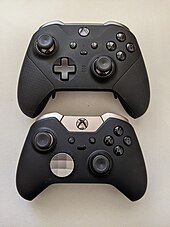
Plans for a revised version of the Elite controller were leaked in January 2018, with a number of new features, including USB-C connector, and other hardware improvements such as three-level Hair Trigger Locks, adjustable tension for the thumbsticks, revised rubber grips, three user-defined profile settings, and Bluetooth connectivity, which had been introduced with the revised Xbox One S controller in 2016.[61][62]
At E3 2019, Microsoft announced they would begin taking pre-orders for the Xbox Elite Wireless Controller Series 2; the controller would be available starting on November 4, 2019 at a suggested retail price of US$179.99.[63]
In general, accessories (such as the thumbsticks and paddles) are not interchangeable between the Series 2 and Series 1 Elite controllers.[64] The case bundled with the Elite 2 included a removable charging dock (Model 1924) for the controller's built-in battery and a pass-through to connect a USB-C cable with a port on the dock.[65]
Support on other platforms
Drivers were released in June 2014 to allow Xbox One controllers to be used over a USB connection on PCs running Windows 7 or later.[66] The Xbox One Wireless Adapter for Windows is a USB dongle that allows up to eight controllers to be used at once wirelessly.[67]
Per a partnership between Microsoft and Oculus VR, the Oculus Rift CV1 virtual reality headset initially included an Xbox One controller, up until the launch of the Oculus Touch motion controllers.[68]
On Windows 10, support for the controller is built-in, including support for wireless audio when using the wireless dongle or USB cable (it is not supported over Bluetooth). The controller is also manageable via the Xbox Accessories app, whose features include button remapping (for both the regular and Elite controller), input tests, and firmware update. On Windows 7 or 8.1, drivers are required, and the aforementioned features are not available.[69]
Microsoft also supports Bluetooth-enabled Xbox One controllers on Android, specifically listing support for Minecraft: Gear VR Edition on certain Samsung Galaxy devices.[70]
On Linux, Xbox One controllers are supported by the xpad USB driver.[71] There also exists an alternative xpadneo driver, which supports some controller revisions that are not supported by the xpad driver, as well as additional features. Some of these additional features, such as driver support for the trigger rumble motors, aren't even supported on Windows 10.[72]
In June 2019, Apple announced support for Bluetooth-enabled Xbox One controllers in iOS 13, macOS Catalina and tvOS 13, which became available in the fall of 2019.[73][74]
Accessories
Chat Headset
The Xbox One Wired Chat Headset (Model 1564) is a single-ear headset with a boom microphone permanently wired to an adapter that plugs into the rectangular expansion port on the bottom edge of the Xbox One controller; it also engages the two round holes flanking the expansion port with plastic alignment prongs for stability. There are three buttons on the adapter, which allow the player to adjust chat volume and mute the microphone. A version of the Chat Headset was later available with a standard 3.5 mm headphone jack instead of the adapter; on the updated version, the controls were on a small plastic pod inline with the cable.[6]
Stereo Headset Adapter

The original Xbox One Wireless Controller (Model 1537) has a 2.5 mm monaural headset jack on the bottom edge of the controller.[75] The Xbox One Stereo Headset Adapter (Model 1626) allows the use of stereo headsets with 3.5 millimeter headphone jacks using the rectangular expansion port on the bottom center of all Microsoft Xbox One controllers, including the original (Model 1537). An adapter for 2.5 mm headphone jacks is also included.[76] Using the monaural headset jack on the original controller only provides chat audio, not in-game audio (music and sounds); the Stereo Headset Adapter routes both chat and in-game audio to the headset instead.[77] The Stereo Headset Adapter includes five buttons which allow the player to balance chat and in-game audio output levels, adjust overall volume, and mute the chat microphone.[75] It was available both separately and in a bundle with the Xbox One Stereo Headset (Model 1610).[77]
Chatpad

The Microsoft Chatpad keyboard attachment (Model 1676), similar to the Xbox 360 Messenger Kit, was unveiled at Gamescom on August 4, 2015.[78] The Chatpad also includes the functions of the Stereo Headset Adapter and was bundled with the updated version of the Chat Headset terminating in a 3.5 mm headphone jack. In addition, the Chatpad features two dedicated programmable keys; the default behavior allowed the player to record screenshots (X1) and gameplay clips (X2) without using a software menu, if that functionality is enabled in the Xbox Dashboard settings.[79][80]
Play and Charge Kit
Similar to the Xbox 360 version, the Play and Charge Kit (Model 1556/1727) is the official rechargeable battery pack for Xbox One controllers; it includes both the battery, which is installed in the existing battery compartment, and a charging cable, which allows players to charge the controller while playing a game. The cable is a standard USB-A to micro-USB cable 9 ft (2.7 m) long,[81] equipped with an indicator light that provides state of charge information, glowing orange while charging and green or white when complete.[82] The bundled Xbox One Li-Ion Rechargeable Battery has a 1400 mA-hr capacity at 3.0V.
The Play and Charge Kit was renamed to the Xbox Rechargeable Battery + USB-C Cable and released for the Series X/S controllers in 2020. The rechargeable battery pack is physically identical to the older version, and the update to the kit is limited to the bundled cable, which is now a 9 ft (2.7 m) USB-A to USB-C cable instead of micro USB.[83] The indicator light has been dropped from the updated cable.[82][83]
Xbox Wireless Adapter for Windows
The Xbox Wireless Adapter for Windows (Model 1713) is a USB-A dongle with a single button that allows computers using the Windows 10 and Windows 11 operating system to connect with Xbox controllers, headsets, and similar accessories via the proprietary Xbox Wireless protocol rather than Bluetooth.[84] It was announced in June 2015[85] and began shipping in October of that year.[86] Support for Windows 7 and 8.1 was added through new drivers in December 2015.[67][87] It is equipped with a single white LED to indicate pairing and wireless connection status.[88]
A revised version, now named the Xbox Wireless Adapter for Windows 10 (Model 1790) was introduced in August 2017 with a smaller size, reducing potential physical interference with adjacent USB ports.[89][90] As noted by its name, the revised Model 1790 drops support for Windows 7 and 8.1.[91]
References
- ^ "The Xbox One controller: Projectors, smells (!), and other stuff that didn't make it in (part 1, exclusive)". VentureBeat. November 18, 2013. Retrieved April 9, 2015.
- ^ "Update your Xbox One Controller to use the Stereo Headset Adaptor". xbox.com. Microsoft. Retrieved February 1, 2015.
- ^ a b "The Xbox One controller: A look at the new rumble, faster speed, smooth design, and everything else (part 4, exclusive)". VentureBeat. Retrieved June 11, 2015.
- ^ a b "Xbox One controller can be plugged in via USB to save power". Eurogamer. Retrieved January 10, 2015.
- ^ Goldfarb, Andrew (May 24, 2013). "Microsoft Explains Xbox One Controller's New Buttons". IGN.com. Retrieved May 26, 2013.
- ^ a b "Set up and use the Xbox One Chat Headset". Xbox Support. Retrieved November 22, 2021.
- ^ "The Xbox One controller: What's new with the analog sticks and D-pad (part 2, exclusive)". VentureBeat. Retrieved June 11, 2015.
- ^ a b "The Xbox One controller: What's new with the buttons and triggers (part 3, exclusive)". VentureBeat. Retrieved June 11, 2015.
- ^ Lowe, Scott. "Xbox One Controller Hands-on". May 21, 2013. Retrieved May 22, 2013.
- ^ Warren, Tom (August 16, 2016). "Microsoft's new 'Xbox Wireless' lets PCs support Xbox controllers without dongles". The Verge. Retrieved December 14, 2021.
- ^ Brown, Matt (November 30, 2017). "Xbox Wireless: Everything you need to know". Windows Central. Retrieved December 14, 2021.
- ^ Ruiz, Daniel; Turtle, Will (September 8, 2021). "Xbox Controller Firmware Update Rolling Out to Insiders Starting Today". Xbox Wire. Retrieved December 14, 2021.
- ^ "Xbox One doubles storage to a terabyte, gets jacked-up controller". CNET. Retrieved June 11, 2015.
- ^ "Microsoft Launches Updated Xbox One, Controller, and PC Adapter". Anandtech. Retrieved June 12, 2015.
- ^ a b Dingman, Hayden. "Xbox One S controller review: New features and custom colors make for a great successor". PC World. IDG. Retrieved May 8, 2017.
- ^ "Microsoft announces the Xbox One S, its smallest Xbox yet". The Verge. Vox Media. Retrieved June 13, 2016.
- ^ a b c Webster, Andrew (June 13, 2016). "Xbox Design Lab lets you build your own colorful Xbox One controller". The Verge. Vox Media. Retrieved June 13, 2016.
- ^ "Red Xbox One Controller Launching This Month". GameSpot. Retrieved May 8, 2017.
- ^ a b "Inside The New Xbox Series X Controller: Share Button & More Changes". GameSpot. Retrieved December 13, 2019.
- ^ a b Byford, Sam (December 12, 2019). "The Xbox Series X controller has a tweaked design and a Share button". The Verge. Retrieved December 13, 2019.
- ^ a b Tuttle, Will (March 16, 2020). "Xbox Series X: Making Gaming's Best Controller Even Better". Xbox Wire. Microsoft. Retrieved March 16, 2020.
- ^ Tuttle, Will (March 16, 2020). "Xbox Series X: Making Gaming's Best Controller Even Better". Xbox Wire. Microsoft. Archived from the original on July 29, 2020. Retrieved March 16, 2020.
- ^ "Xbox Support". support.xbox.com. Retrieved September 6, 2021.
- ^ Bonifac, Igor (March 16, 2020). "Microsoft details its low-latency Xbox Series X controller". Engadget. Retrieved September 8, 2021.
- ^ Carr, James (September 8, 2021). "Microsoft Bringing Xbox Series X|S Controller Features To Last-Gen Controllers For Xbox Insiders". GameSpot. Retrieved September 8, 2021.
- ^ Nunneley, Stephany (June 17, 2021). "Xbox Design Lab returns will the ability to customize Xbox Series X/S controllers". VG247. Retrieved June 17, 2021.
- ^ Fogel, Stefanie (August 8, 2013). "Xbox One 'Day One' edition comes with special controller, Achievement". VentureBeat. Retrieved July 20, 2018.
- ^ Warren, Tom (May 28, 2015). "New Xbox One controller will have a standard headphone jack". The Verge. Retrieved July 20, 2018.
- ^ Hryb, Larry. "New Xbox One 1TB Console Unveiled, Xbox One 500GB Console Reduced to $349" (Press release). Microsoft. Retrieved July 20, 2018.
- ^ "How to connect an Xbox One Wireless Controller to PC". Microsoft. Retrieved July 30, 2018.
- ^ Dingman, Hayden (October 22, 2015). "Xbox One Elite Controller review: I'm finally replacing my wired 360 controller". PCWorld. Retrieved July 20, 2018.
- ^ "Xbox Elite Wireless Controller Series 2". Microsoft. Retrieved June 9, 2019.
- ^ "List of all different Xbox One controller styles and colors". WindowsCentral.
- ^ a b "Xbox Design Lab". Microsoft. Archived from the original on August 19, 2016.
- ^ a b c d "Xbox Design Lab". Microsoft. Archived from the original on August 2, 2017.
- ^ a b "Xbox Design Lab". Microsoft. Archived from the original on June 17, 2021.
- ^ a b Auld, Mark (November 11, 2021). "Xbox Design Lab Brings Back Rubberized Grips, Metallic Finishes, and More". Xbox News. Retrieved November 19, 2021.
- ^ a b Kumar, Navin (August 26, 2016). "Eight Million Ways to Personalize Your Xbox Wireless Controller with Xbox Design Lab". Xbox News. Retrieved June 30, 2021.
- ^ Kumar, Navin (August 26, 2016). "Xbox Design lab's First Batch of Controllers Are Shipping Now". Xbox News. Retrieved June 30, 2021.
- ^ White, Bree (June 12, 2017). "Xbox Design Lab Adds More Customization Options and Expands To More Countries". Xbox News. Retrieved June 23, 2021.
- ^ Rubino, Daniel (July 4, 2017). "Everything you need to know about the Xbox Design Lab 2017 custom wireless controller". Windows Central. Retrieved November 22, 2021.
- ^ Petraschuk, Shawn (August 5, 2017). "Xbox Design Lab 2017 Custom Controller Review". COG Connected. Retrieved November 22, 2021.
- ^ Devine, Richard (June 12, 2017). "Xbox Design Lab custom controllers finally come to Europe!". Windows Central. Retrieved June 30, 2021.
- ^ "Xbox Design Lab program expands to 24 new EU countries". Video Gamer. August 22, 2017. Retrieved June 30, 2021.
- ^ Thorp-Lancaster, Dan (November 2, 2017). "Custom NFL Xbox One controllers now available on the Xbox Design Lab". Windows Central. Retrieved November 26, 2021.
- ^ "Cannes Lions winners: Xbox lets fans sell own customised controller designs". Digital Intelligence. June 22, 2018. Retrieved June 30, 2021.
- ^ "Microsoft Xbox's 'Fanchise Model' wins Creative E-Commerce Award". AdAge. Retrieved June 30, 2021.
- ^ Kiefer, Brittaney (June 28, 2018). "Xbox made Cannes Lions history by turning gamers into entrepreneurs". Campaign. Retrieved June 30, 2021.
- ^ "Xbox Design Lab Originals: The Fanchise Model (Public Relations, Bronze)". Clio Awards. 2018. Retrieved June 30, 2021.
- ^ "Xbox Design Lab Originals: The Fanchise Model (Games, Gold)". Clio Awards. 2018. Retrieved June 30, 2021.
- ^ Carbotte, Kevin (August 21, 2018). "Xbox Design lab Now Offers Camo, Shadow Patterns". Tom's Hardware Guide. Retrieved November 26, 2021.
- ^ Thorp-Lancaster, Dan (August 21, 2018). "Xbox Design Lab rolls out new 'Camo' and 'Shadow' options for controllers". Windows Central. Retrieved November 23, 2021.
- ^ Brown, Matt (August 28, 2018). "Are Xbox Design lab's Camo and Shadow options worth the price?". Windows Central. Retrieved November 23, 2021.
- ^ Lyles, Taylor (September 22, 2020). "Microsoft is pausing Xbox Design Lab on October 14th, before you get to unwrap your Series X". The Verge. Retrieved June 23, 2021.
- ^ Warren, Tom (June 17, 2021). "Microsoft's Xbox Design Lab returns for Xbox Series X custom controllers". The Verge. Retrieved June 23, 2021.
- ^ Hunter, James (June 17, 2021). "Xbox Design Lab is Back! Personalize Your Next-Gen Controller and Make It Yours". Xbox News. Retrieved June 23, 2021.
- ^ "Microsoft unveils new $150 Xbox One Elite controller—and we've held it". Ars Technica. Retrieved June 17, 2015.
- ^ "Microsoft's Xbox One Elite Controller could be the ultimate console gamepad". The Verge. Retrieved June 17, 2015.
- ^ Martin Robinson (June 16, 2015). "Microsoft Introduce the New Modular Xbox Elite Wireless Controller". Eurogamer. Retrieved June 21, 2015.
- ^ "Gears of Wars 4 is getting a ridiculously awesome Xbox Elite controller". The Verge. Vox Media. Retrieved May 18, 2017.
- ^ a b "Microsoft unveils new Xbox Elite controller in robot white". The Verge. Retrieved August 30, 2018.
- ^ Warren, Tom (January 16, 2018). "New Xbox Elite controller revealed in leaked images". The Verge. Retrieved June 14, 2019.
- ^ Warren, Tom (June 9, 2019). "Microsoft's Xbox Elite 2 controller arrives on November 4th for $179.99". The Verge. Retrieved June 9, 2019.
- ^ Plunkett, Luke (March 22, 2021). "My New Xbox Elite Controller Has A Long Shortcoming". Kotaku. Retrieved December 23, 2021.
- ^ "Charge your Xbox Elite Wireless Controller Series 2". Xbox Support. Retrieved December 23, 2021.
- ^ "PC Drivers for the Xbox One Controller Now Available". MajorNelson (Larry Hryb). June 5, 2014. Retrieved March 22, 2015.
- ^ a b "You No Longer Have to Be on Windows 10 to Use the Xbox One Wireless Adapter". GameSpot. CBS Interactive. Retrieved December 10, 2015.
- ^ "Explained: How the Oculus Rift streams PC and Xbox One games". CNET. Retrieved June 14, 2015.
- ^ "Xbox One Wireless Controller differences on Windows operating systems". Xbox. Microsoft. Retrieved March 19, 2016.
- ^ "Xbox Wireless Controller Functionality Across Operating Systems". support.xbox.com. Retrieved October 6, 2017.
- ^ "17. xpad - Linux USB driver for Xbox compatible controllers — The Linux Kernel documentation". www.kernel.org. Retrieved December 8, 2020.
- ^ Dollinger, Florian (December 7, 2020), atar-axis/xpadneo, retrieved December 8, 2020
- ^ "tvOS 13 powers the most personal cinematic experience ever". Apple Newsroom. Retrieved June 7, 2019.
- ^ Rossignol, Joe. "iPhone, iPad, and Apple TV Gaining Xbox One and PlayStation 4 Controller Support". www.macrumors.com. Retrieved June 7, 2019.
- ^ a b Greenwald, Will (May 28, 2014). "Microsoft Xbox One Stereo Headset Adapter Review". PCMag. Retrieved November 22, 2021.
- ^ "Some caveats come with Xbox One headset adapter [update]". Engadget. Retrieved June 11, 2015.
- ^ a b "Xbox One Stereo Headset and Adapter Coming in Early March". Xbox Wire. February 11, 2014. Retrieved November 22, 2021.
- ^ "Xbox One controllers get a chatpad this November". Polygon. Retrieved August 4, 2015.
- ^ Acevedo, Paul (November 29, 2015). "Microsoft Chatpad review: A small, sleek keyboard for Xbox One & Windows 10". Windows Central. Retrieved November 22, 2021.
- ^ "Set up and troubleshoot the Xbox One Chatpad". Xbox Support. Retrieved November 22, 2021.
- ^ "Xbox One Wireless Controller, Play and Charge Kit and Chat Headset available for pre-order". Engadget. Retrieved June 9, 2016.
- ^ a b Honorof, Marshall (January 17, 2021). "Xbox Series X recharegable battery is a huge step back". Tom's Hardware Guide. Retrieved November 22, 2021.
- ^ a b Brown, matt (July 6, 2021). "Best Xbox Series X and Series S charger, battery, and power accessories 2021". Windows Central. Retrieved November 22, 2021.
- ^ "The Xbox One wireless controller adapter is exclusive to Windows 10 for...reasons". PC World. Retrieved June 11, 2015.
- ^ Major Nelson (June 9, 2015). "New Xbox One 1TB Console Unveiled, Xbox One 500GB Console Reduced to $349". Xbox Wire. Retrieved December 14, 2021.
- ^ Major Nelson (October 20, 2015). "Xbox Wireless Adapter for Windows Begins Shipping Today". Xbox Wire. Retrieved December 14, 2021.
- ^ Dingman, Hayden (December 11, 2015). "Xbox One wireless controller adapter now supports Windows 7 and Windows 8.1". PCWorld. Retrieved December 14, 2021.
- ^ "Troubleshoot the Xbox Wireless Adapter for Windows". Xbox Support. Retrieved December 14, 2021.
- ^ "Microsoft's new Xbox Wireless Adapter is no longer a massive USB stick". The Verge. Retrieved October 6, 2017.
- ^ White, Bree (August 1, 2017). "Score Style Points with New Xbox Wireless Controllers Featuring Sleek New Designs and Colors". Xbox Wire. Retrieved December 14, 2021.
- ^ "Set up the Xbox Wireless Adapter for Windows". Xbox Support. Retrieved December 14, 2021.




